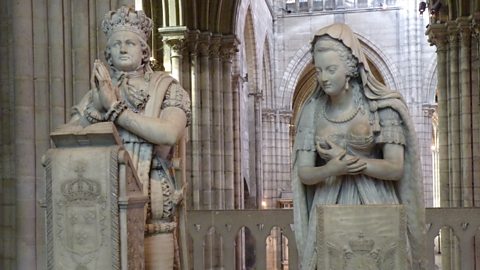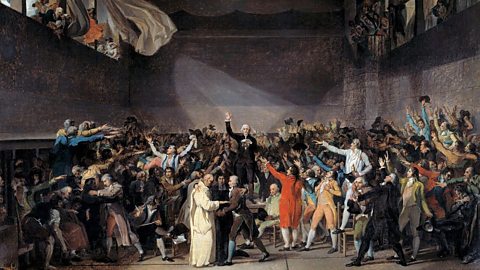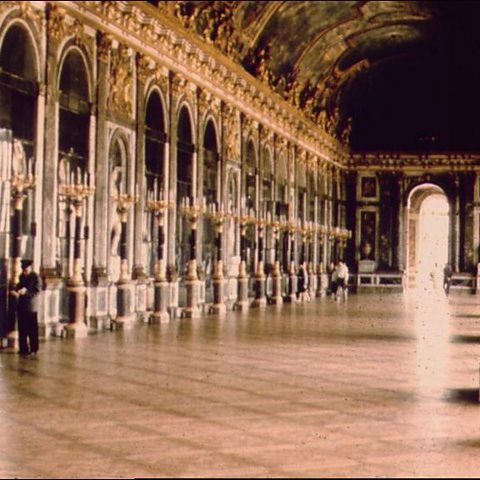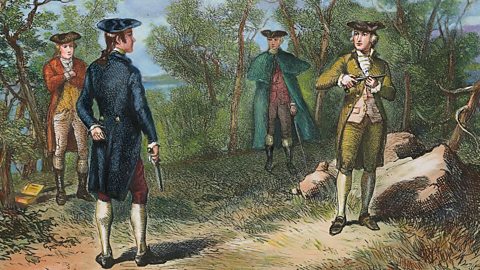Without doubt, the French Revolution of 1789 was a momentous occasion in history. After all, it was an uprising that brought down a European monarchy.
But how much of what we know about the French Revolution is actually true, and how much is myth and exaggeration? Did Marie Antoinette really say "Let them cake" and did the revolutionaries truly fight for equality?
 Image source, Â鶹ԼĹÄ
Image source, Â鶹ԼĹÄMarie Antoinette didn’t say let them eat cake
As the story goes, when Queen Marie Antoinette heard that the French peasants were starving and didn’t have enough bread, she exclaimed “Let them eat cake”. Cake was more expensive than bread, so this response would show how out of touch Marie Antoinette was. But it simply isn’t true.
For starters, there’s been a mistranslation into English. Marie Antoinette supposedly spoke of brioche, which is actually a type of luxurious sweet bread, not cake.
However, there is no documentation or eyewitness reports that record her ever say anything similar. In fact, the phrase was only ascribed to Marie Antoinette 50 years after her death in 1843, by the writer Jean-Baptiste Alphonse Karr in a journal called Les GuĂŞpes. Even then, he writes of how the rumour is false.
Marie Antoinette was heavily disliked by many of the French people, who believed that her fondness for expensive fashion was helping to push France closer to financial ruin, giving her the nickname Madame Deficit. In fact, France’s support for the revolutionaries in the American War of Independence had a far greater impact on its finances, costing over a billion livres (French currency of the period).
However, it also didn’t help that Marie Antoinette was Austrian, a long-time enemy of France.
The revolution wasn’t led by peasants
It might have the image of being a mighty revolt from the French commoners against the monarchy, but the French Revolution was lead by the bourgeoisie from the start.
In May 1789, King Louis XVI called a meeting of the Estates-General, to try and find a solution to France’s financial problems. It brought together 1200 delegates from the clergy (the First Estate), the nobility (the Second Estate) and the common people (the Third Estate).
The Third Estate disagreed with the King’s plans to raise taxes, and splintered off to form their own group, called the National Assembly. Initially, most of the delegates’ aim was to limit the extent of the King’s power, but not totally abolish the monarchy.
 Image source, Â鶹ԼĹÄ
Image source, Â鶹ԼĹÄ Image source, Photo Josse/Leemage
Image source, Photo Josse/LeemageNamed for the location of their meetings, on 20 June 1789 they took the Tennis Court Oath: “We shall not disperse until we have established a sound and just constitution, as instructed by those who nominated us.”
These initial steps towards revolution were taken by members of the bourgeoise, not the peasants. The delegates were upper-middle class, and worked in professions such as law and medicine. They would even be joined by a few aristocrats, including the Marquis de La Fayette, who worked with the American Thomas Jefferson to draft The Declaration of the Rights of Man.
 Image source, Â鶹ԼĹÄ
Image source, Â鶹ԼĹÄThe revolution didn’t provide equality for all
While the motto of the French revolution was “liberty, equality, fraternity”, in practice this did not apply to everyone. Only wealthy men over the age of 25 were given the right to vote for deputies in the National Assembly and slavery was not abolished until 1794. It was then reinstated by Napoleon in 1802 and abolished again in 1848.
Less well known than the storming of the Bastille, are the events of 5 October 1789. On this day, thousands of women from Paris marched on the Palace of Versailles, expressing their outrage about an ongoing bread shortage and forcing the royal family back to Paris.
The next day, the Declaration of the Rights of Man was finally signed. However, it did not make women equal citizens in the eyes of the law.
A female French playwright called Olympe des Gouges argued in a pamphlet that if women could be sentenced to death, they should also be allowed to have their opinions heard. She wanted women to be allowed to vote and be elected to government. She opposed the execution of King Louis XVI and wanted the people of France to choose their own form government, without violence. For this she was branded a traitor and sent to the guillotine on 3 November 1793.
 Image source, Â鶹ԼĹÄ
Image source, Â鶹ԼĹÄ Image source, Â鶹ԼĹÄ
Image source, Â鶹ԼĹÄThere wasn’t just one revolution
You might be under the impression that once King Louis XVI had been executed in 1793 and the monarchy was overthrown, that was it. But the monarchy did return, and there were several more revolutions and rebellions to come.
When Emperor Napoleon Bonaparte was overthrown in 1814, the Bourbon dynasty was restored to the throne, with King Louis XVI’s younger brother becoming King Louis XVIII.
It was the June Rebellion in 1832, also known as the Paris Uprising, that the author Victor Hugo used as inspiration for his historical novel Les Miserables, later to be transformed into the famous musical. This rebellion took place 43 years after the storming of the Bastille!
 Image source, Â鶹ԼĹÄ
Image source, Â鶹ԼĹÄPirate history: true or false?
Buried treasure, walking the plank, the Jolly Roger- how much of it is true?

Digging into the history behind Hamilton
Slavery, the 1800 election and Angelica Schuyler.

Five unusual protests in history
For years people have found interesting and creative ways of getting their voices heard.
